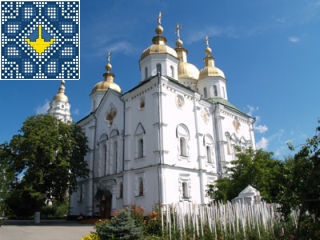|
Poltava Sights | Holy Cross Exaltation Monastery Individual and group tours to Poltava |
Holy Cross Exaltation Monastery was founded of the initiative and the expenses of Poltava Colonel Martyn Pushkar, Ivan Iskra, cossack officers and residents of Poltava with the permission of Kiev Metropolitan Sylvester Kosov after the defeat of the troops of Polish magnates and gentry near Poltava. The monastery was building under the guidance of abbot Kalistrat of Mgarsky Monastery. In 1695 Holy Cross Exaltation Monastery was invaded and devastated by Crimean Tatars who have come to Poltava with a former senior clerk of the General Office of Military - Petrick (Petr Ivanenko). In 1691 he fled to Crimea and signed an agreement to transfer the Left-Bank Ukraine under the authority of the Sultan of Turkey declaring himself as hetman opposed the Moscow authorities in Ukraine and against the hetman Ivan Mazepa and together with Tatars began invasion on the Left-Bank Ukraine. But the Tartars capturing booty betrayed Petrik. At the end of the XVII century old wooden Holy Cross Exaltation Cathedral was demolished and the construction of a new stone church was at the expense of general judge of Left-Bank Ukraine - Vasyl Kochubey. But in 1708 Vasyl Kochubey along with former Poltava colonel Ivan Iskra were executed on the orders of Ivan Mazepa for their denunciations of him to Tsar Peter I. In connection with these events the construction of the new Holy Cross Exaltation Cathedral was stopped. In 1709 Holy Cross Exaltation Monastery was destroyed by Swedish troops. Capturing the monastery Swedes have fired from the Monastery Hill into Poltava fortress. Later one of the Swedish guns were moved from Holy Cross Exaltation Monastery into Battle of Poltava Field where it was for a long time near Communal Grave of Russian Soldiers which also known as "Swedish Grave". Holy Cross Exaltation Monastery was the headquarters of the Swedish King - Charles XII of Sweden. There was a mill from which according to legends Charles XII of Sweden sent orders to the troops during the assault of Poltava. Nearby the monastery Charles XII of Sweden on 17th of June 1709 was wounded by a bullet in the leg by some cossack during an inspection of outposts just ten days before famous Battle of Poltava. After the expulsion of the Swedes already late in the first quarter of XVIII century the son of Vasyl Kochubey have finished the work of building of Holy Cross Exaltation Cathedral. The first iconostasis of Holy Cross Exaltation Cathedral served as the famous master of XVIII century Vasil Reklinsky. And the second - four-story, carved, basswood, gilded, baroque - completed in 1772 by Russian and Ukrainian engraver Sisoy Shalmatov. Wonderful iconostasis of Holy Cross Exaltation Church of Holy Cross Exaltation Monastery was destroyed in 1933. The second monastery church - Holy Trinity Church was built in 1750. Holy Trinity Church was considered as the refectory. In 1786 in Holy Cross Exaltation Monastery was built four-tiered bell tower. The construction was of the wonderful Italian architecture with elements of Ukrainian Baroque. The bell tower was close to the style of the bell tower of Kiev-Pechersk Lavra and was decorated with a variety of classical stucco elements. Its height is 47 meters. On the bell tower was ten bells of different sizes and the proud of it was a huge bell weighing more than 6,5 tons. Since 1881 in Holy Cross Exaltation Monastery existed its own brick factory which made the possibility to produce cheap and high-quality bricks for the construction of communal cells and various outbuildings. However for the brick factory has been cut down much of the beautiful century-old oak forest. In 1923 Holy Cross Exaltation Monastery was closed. In one of its rooms arranged the club, the other used by Poltava Historical Archives. From 1933 until the end of the 30-s in the monastery was placed Poltava Child Labor Camp. During World War II when Poltava was temporarily occupied by Nazi invaders in 1942 the community of nuns asked for permission to open in the remaining areas of the former Holy Cross Exaltation Monastery a nunnery. From this year and begins its work on women's monastery on the Monastery Hill. During the bombing and shelling facilities were severely damaged including the main Holy Cross Exaltation Cathedral. In the postwar years gradually by donations was done the restoration and renovation of Holy Cross Exaltation Monastery buildings. In 1956 was built Holy Cross Exaltation Cathedral which at that time since the war was ruins. On 25th of November 1958 by the direction of Poltava Executive Committee was decided to close Holy Cross Exaltation Monastery in Poltava and gave it territory for students hostels of Pedagogical Institute. But for various reasons the eviction of nuns was delayed. Then Office of Poltava Regional Communist Party on 30th of June 1960 took clear and unequivocal decision: conduct a closing of Poltava nunnery and Holy Cross Exaltation Monastery. This decision was made in one night. On the morning of 8th of July 1960 the monastery was close and 87 nuns and novices who at that time lived in it - 48 was taken to Lebedinskij Nicholas Monastery in the Cherkasy region and the remaining 39 nuns were taken to their homes to stay with relatives. On 9th of July 1946 Holy Cross Exaltation Monastery was registered as cultural and historic monument but it did not save the unique building. In one of the churches inserting entrance gates arranged a workshop to repair vehicles. The roof of the bell tower after repairs carried out by Poltava Regional and Urban Organization of Ukrainian Society for Protection of Monuments of History and Culture was burned by teenagers. The Executive Committee of Poltava Regional Council of People's Deputies on 19th of February 1990 the buildings of Holy Cross Exaltation Monastery which at that time were in the use of Poltava regional organization "Medtech" were transferred to Poltava Eparchy for restoration. But it took almost two years for the religious community to get the territory of Holy Cross Exaltation Monastery. So only on 19th of December 1991 Poltava Holy Cross Exaltation Monastery was finally opened. You could visit Ukraine Poltava Sights | Holy Cross Exaltation Monastery with Ukraine Tour East Ring |

Book your tour or request information: |
|
- please, look at reviews of tourists about our tours
|
© 2011 - 2022 All rights reserved |


